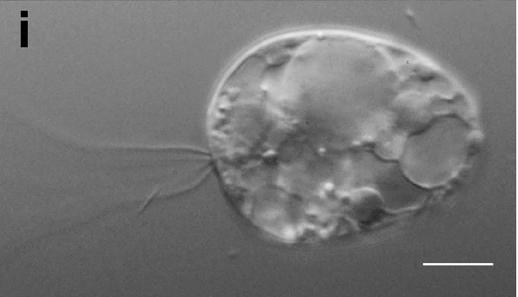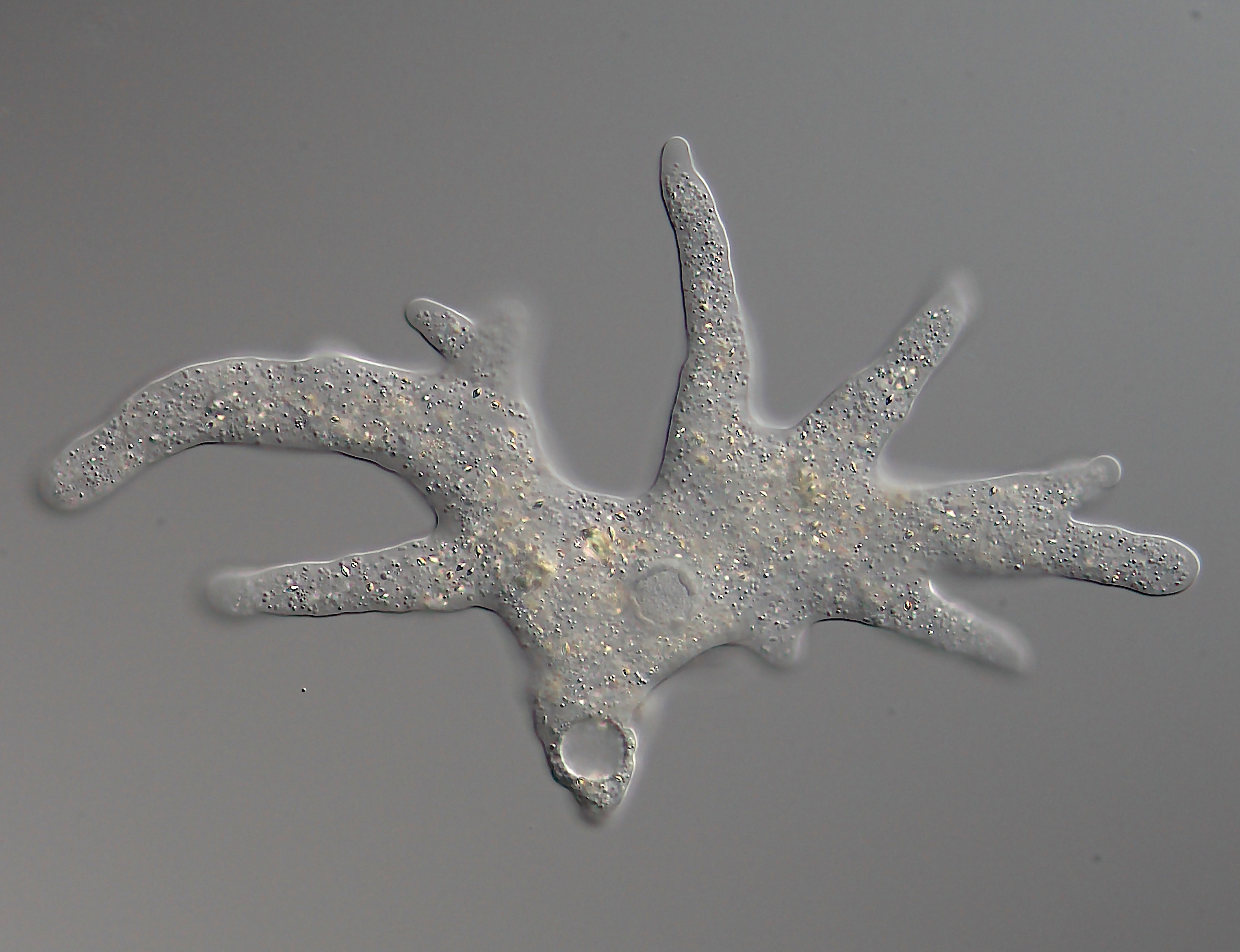|
Apusozoa
The Apusozoa are a paraphyletic phylum of flagellate eukaryotes. They are usually around 5–20 μm in size, and occur in soils and aquatic habitats, where they feed on bacteria. They are grouped together based on the presence of an organic shell or theca under the dorsal surface of the cell. The name derives from the Ancient Greek words for footless () and animal (). This phylum was defined as containing the Breviata and the Apusomonadida. However, it is viewed as paraphyletic, with the Breviata as more basal. The opisthokonts appear to have emerged as sister of the Apusomonadida. It has been suggested that the Mantamonadida be classified in Apusozoa. The Ancyromonadida appear to be Varisulca, Planomonadida, shifting them possibly more basal than the Amoebozoa, or less basal. While some classification systems have placed Hemimastigida in Apusozoa, 2018 research indicated that hemimastigotes (/Hemimastix/ Spironematellidae) are their own supra-kingdom. Characteristics The ... [...More Info...] [...Related Items...] OR: [Wikipedia] [Google] [Baidu] |
Varisulca
Varisulca was a proposed basal Podiate taxon. It encompassed several lineages of heterotrophic protists, most notably the ancyromonads (planomonads), collodictyonids (diphylleids), rigifilids (''Rigifila'', ''Micronuclearia'') and mantamonads. Recent evidence suggests that the latter three are closely related to each other, forming a clade called CRuMs, but that this is unlikely to be specifically related to ancyromonads. Cavalier-Smith had proposed the new subphylum Varisulca which consists of the classes Hilomonadea, Diphyllatea and Glissodiscea. The validity of this proposed taxonomy has yet to ruled upon by the Society of Protistologists. It is unlikely to be widely accepted, since Varisulca appears to be paraphyletic or polyphyletic (ancyromonads are not inferred to be the sister group to CRuMs). Glissodiscea and Multirhiza (a taxon encompassing Diphyllatea and Glissodiscea) also appear paraphyletic or polyphyletic, since ''Mantamonas'' belongs to CRuMs but ancyromon ... [...More Info...] [...Related Items...] OR: [Wikipedia] [Google] [Baidu] |
Apusomonadida
The apusomonads (family Apusomonadidae) are a group of protozoan zooflagellates that glide on surfaces, and mostly consume prokaryotes. They are of particular evolutionary interest because they appear to be the sister group to the Opisthokonts, the clade that includes both animals and fungi. Together with the Breviatea, these form the Obazoa clade. Characteristics Apusomonads are small gliding heterotrophic biflagellates (i.e. with two flagella) that possess a proboscis, formed partly or entirely by the anterior flagellum surrounded by a membranous sleeve. There is a pellicle under the dorsal cell membrane that extends into the proboscis sleeve and into a skirt that covers the sides of the cell. Apusomonads present two different cell plans: *Derived cell plan, represented by '' Apusomonas'', with a round cell body and a mastigophore, a projection of the cell containing both basal bodies at its end. *"''Amastigomonas''-like" cell plan, with an oval or oblong cell that gener ... [...More Info...] [...Related Items...] OR: [Wikipedia] [Google] [Baidu] |
Thecomonadea
The apusomonads (family Apusomonadidae) are a group of protozoan zooflagellates that glide on surfaces, and mostly consume prokaryotes. They are of particular evolutionary interest because they appear to be the sister group to the Opisthokonts, the clade that includes both animals and fungi. Together with the Breviatea, these form the Obazoa clade. Characteristics Apusomonads are small gliding heterotrophic biflagellates (i.e. with two flagella) that possess a proboscis, formed partly or entirely by the anterior flagellum surrounded by a membranous sleeve. There is a pellicle under the dorsal cell membrane that extends into the proboscis sleeve and into a skirt that covers the sides of the cell. Apusomonads present two different cell plans: *Derived cell plan, represented by '' Apusomonas'', with a round cell body and a mastigophore, a projection of the cell containing both basal bodies at its end. *"''Amastigomonas''-like" cell plan, with an oval or oblong cell that g ... [...More Info...] [...Related Items...] OR: [Wikipedia] [Google] [Baidu] |
Apusomonas
''Apusomonas'' is a genus of Apusozoa The Apusozoa are a paraphyletic phylum of flagellate eukaryotes. They are usually around 5–20 μm in size, and occur in soils and aquatic habitats, where they feed on bacteria. They are grouped together based on the presence of an organic shel ... erected by A. G. Aléxéieff in 1924. It includes the species ''Apusomonas proboscidea''. References Apusomonadida Amorphea genera Protist genera {{Unikont-stub ... [...More Info...] [...Related Items...] OR: [Wikipedia] [Google] [Baidu] |
Podiata
Podiates (Cavalier-Smith, 2012, excl. Ancyromonadida) are a proposed clade containing the Amorphea (incl. Opisthokonta, Amoebozoa, apusomonads and breviates) and the organisms now assigned to the clade CRuMs. Ancyromonadida does not appear to have emerged in this grouping. Sarcomastigota (Cavalier-Smith, 1983) is a proposed subkingdom (currently shown to be paraphyletic) that includes all the podiates that are ''not'' animals or fungi. Sulcozoa (Cavalier-Smith, 2012) is a proposed phylum (currently shown to be paraphyletic) within Sarcomastigota that does not include the phyla Amoebozoa (clade In biology, a clade (), also known as a Monophyly, monophyletic group or natural group, is a group of organisms that is composed of a common ancestor and all of its descendants. Clades are the fundamental unit of cladistics, a modern approach t ...) and Choanozoa (paraphyletic), i.e. it includes the proposed subphyla Apusozoa and Varisulca.. References {{Taxonbar, from=Q ... [...More Info...] [...Related Items...] OR: [Wikipedia] [Google] [Baidu] |
Supra-kingdom
In biology, a kingdom is the second highest taxonomic rank, just below domain. Kingdoms are divided into smaller groups called phyla (singular phylum). Traditionally, textbooks from Canada and the United States have used a system of six kingdoms (Animalia, Plantae, Fungi, Protista, Archaea/Archaebacteria, and Bacteria or Eubacteria), while textbooks in other parts of the world, such as Bangladesh, Brazil, Greece, India, Pakistan, Spain, and the United Kingdom have used five kingdoms (Animalia, Plantae, Fungi, Protista and Monera). Some recent classifications based on modern cladistics have explicitly abandoned the term ''kingdom'', noting that some traditional kingdoms are not monophyletic, meaning that they do not consist of all the descendants of a common ancestor. The terms ''flora'' (for plants), ''fauna'' (for animals), and, in the 21st century, ''funga'' (for fungi) are also used for life present in a particular region or time. Definition and associated terms When Car ... [...More Info...] [...Related Items...] OR: [Wikipedia] [Google] [Baidu] |



